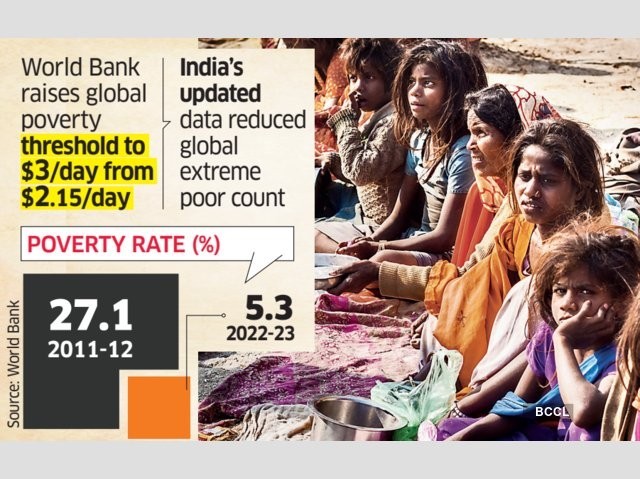views
India's Poverty Eradication Success: 269 Million Lifted

India, a nation of immense diversity and dynamic growth, has achieved a truly monumental feat in its fight against extreme poverty. According to recent data released by the World Bank, a staggering 269 million people were lifted out of extreme poverty in India over an 11-year period, from 2011-12 to 2022-23. This remarkable achievement underscores a profound socio-economic transformation and positions India as a significant contributor to global poverty reduction efforts, even as the World Bank adjusted its international poverty line.
The World Bank defines "extreme poverty" based on an updated international poverty line of $3.00 per person per day (in 2021 purchasing power parity terms). By this rigorous standard, India’s extreme poverty rate plummeted from 27.1% in 2011-12 to a mere 5.3% in 2022-23. In absolute numbers, this means the population living in extreme poverty shrank from 344.47 million to just 75.24 million, a decline that represents one of the fastest rates observed globally.
Drivers of a Decisive Decline
This substantial reduction is not a mere statistical anomaly but a reflection of concerted efforts and a confluence of factors:
- Sustained Economic Growth: India's robust economic expansion over the past decade has played a pivotal role. Rapid GDP growth has translated into increased opportunities, higher real wages, and improved household consumption across various segments of society. The "rising tide lifts all boats" principle appears to have been strongly at play, with the benefits of growth increasingly reaching the most vulnerable.
- Targeted Social Welfare Programs: A wide array of government initiatives has been instrumental in creating a robust social safety net. Programs focusing on financial inclusion (e.g., Jan Dhan Yojana), affordable housing (e.g., PM Awas Yojana), access to clean cooking fuel (e.g., Ujjwala Yojana), and healthcare (e.g., Ayushman Bharat) have directly improved the living standards and resilience of millions.
- Direct Benefit Transfers (DBT): The widespread adoption of direct benefit transfers, facilitated by digital infrastructure like Aadhaar and bank accounts, has significantly reduced leakages and ensured that subsidies and welfare benefits reach the intended beneficiaries efficiently and transparently. This has empowered households, particularly in rural areas.
- Rural Development Focus: Initiatives aimed at strengthening rural infrastructure, providing guaranteed employment (like MGNREGA), and improving connectivity have uplifted rural economies, where a significant proportion of the extreme poor reside. The decline in rural extreme poverty from 18.4% to 2.8% in the same period is particularly noteworthy, closing the gap with urban poverty.
- Multidimensional Approach: Beyond monetary income, India has also made significant strides in reducing multidimensional poverty, which accounts for deprivations in health, education, and standard of living. The Multidimensional Poverty Index (MPI) saw a substantial drop, indicating broad-based improvements in quality of life.
A Global Benchmark
India's success stands out at a time when global poverty reduction efforts have faced setbacks, partly due to various global crises. The scale of this achievement—lifting a population larger than many countries out of extreme deprivation—provides a powerful testament to the impact of strategic policy, inclusive growth, and sustained political will.
While challenges like inequality and climate vulnerability persist, India's journey offers valuable lessons for other developing nations. The commitment to empowering its citizens through economic opportunities and targeted social support has paved the way for a more equitable and prosperous future. This World Bank affirmation is not just a statistic; it's a recognition of the transformed realities for hundreds of millions of Indians who now have access to basic necessities and a pathway to a better life.




















Comments
0 comment